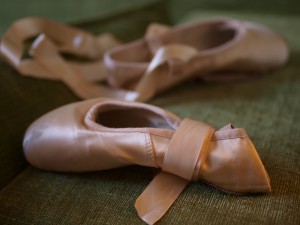Kristen’s post, “There’s A Reason Why We Do The Boring Exercises,” reminded me of advice I once heard: “Every dancer — even a professional — should take a beginner class once in awhile.” Initially puzzled, I gradually understood this statement.
For the past two years I have studied with a wonderful teacher at my studio’s Beginner II (Beg II) and Advanced Beginner (AB) levels. The labels are a bit misleading; the Beg II class uses vocabulary that presumes previous training and the AB class — often attended by professional dancers — moves rapidly through complex combinations. Instructing levels from Beg II to professional company classes, my teacher pays meticulous attention to and offers corrections to dancers of all abilities and training experiences.
When first returning to ballet, I took Beg II class twice a week. Eventually I realized that in order to progress, I needed to try the AB level. I worked up the nerve after
- my studio cancelled my second Beg II class;
- I learned that my excellent Beg II teacher also instructed an AB class that fit my now “freer” schedule;
- and my neighbor (a professional ballerina) convinced me to accompany her to this teacher’s AB class … and I survived.
Despite feeling intimidated, I was relieved to hear the some of the steps taught in Beg II … only now quickly executed in longer, more complex combinations. During the first few AB classes, I was happy just to survive barre before getting lost when we moved to the center. After a month of barely managing to keep my head above water, I actually could keep up somewhat without fear of getting in anyone else’s way (i.e., becoming ballet roadkill). Most importantly, I committed myself to venturing into my teacher’s Thursday AB class while continuing her Tuesday Beg II class.
Why? I discovered that practicing basic technique and simple steps in Beg II before applying them in more complex combinations in AB class was a great formula for improvement. In Beg II class, the teacher breaks down steps that are taken for granted in AB class.
For example, I had no idea what a demi-contretemps step was. In the AB class when dancers reversed direction mid-combination with a demi-contretemps step, I just stared in confusion (they looked like they were almost tripping themselves!); I would simply switch direction to keep up (and not get run over). Then one day in the Beg II class, my teacher dissected a demi-contretemps and I actually understood the step’s proper mechanics. Two days later in AB class when I again encountered the demi-contretemps, I tried to execute the step instead of merely running in the opposite direction. Of course my demi-contretemps step was not good right away, but at least I had learned and could work on the step’s proper technique.
In Beg II class my teacher also isolates specific steps for us to practice that she mixes together in AB class combinations. For example, in Beg II class we can practice proper technique (i.e. spotting, arm and leg positioning, balancing in passé in full releve for a complete rotation, etc.) for a specific pirouette or turn by executing lines of the same step across the room. Then we practice simple combinations of alternating steps (like one pique turn en dedans, then one pique turn en dehors, repeat to end.) Therefore, by the next AB class, when this same teacher gives out combinations of different pirouettes and turns mixed together, I can concentrate on each step’s technique.
My teacher tells us in Beg II class that when she teaches or observes the higher level classes (i.e., AB, Intermediate and above), she sometimes witnesses “bad behavior” — poor habits, sloppiness and incorrect form as advanced dancers move quickly through complicated combinations. Beg II class provides valuable opportunities to hone proper technique under close observation with helpful corrections … so I’m not just imitating others or guessing at steps in AB in order to keep up with (and stay out of the way of) other dancers.





